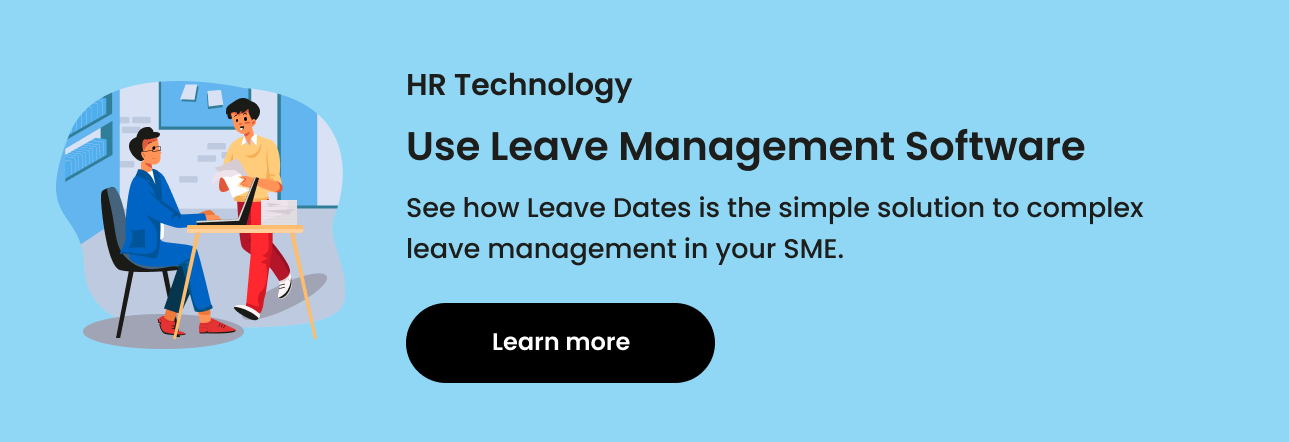
If we summarise the world of work in one word over the last two decades, it would be ‘Automation’. In seemingly every process, from workforce management to onboarding to data capture and analysis, automation is forging more competent, stable, and effective systems.
The HR industry hasn’t escaped this trend, with HR leaders using automated systems to streamline employee hiring, payroll management, and people operations. Leave management is a small yet vital part of managing the employee experience that HR teams are tasked with.
Alongside the regulatory need to offer employees holiday days, businesses are increasingly understanding the productivity benefits of offering more time off. However, as a business expands, manually tracking who is on leave, who wants to be off when, and whether HR has approved a leave request or not, becomes challenging.
Especially as businesses contend with an internationally dispersed workforce, managing who is on holiday and when has become increasingly complex in recent years. The rise of remote and hybrid working structures post-COVID has only served to intensify the need for a more effective method of managing time off requests.
Automating this system reduces errors, streamlines the process, and ensures that no holiday goes untaken. Businesses that want to move toward a more effective method of managing leave have two options: specialised leave management software and generalist HR software.
In this article, we’ll break down the differences between these options, demonstrate their respective benefits, and outline how to select the best option for your business.
Let’s dive right in.
Source: The Effects of Automation at Work.
Table of Contents
- What Challenges Do Small Businesses Face With Manual Leave Tracking?
- Benefits of Using Leave Management Software
- Benefits of Using HR Software
- Leave Management Software vs. HR Software: How to Choose the Right Solution for Your Business
What Challenges Do Small Businesses Face With Manual Leave Tracking?
When a business only manages a handful of employees, leave management is fairly straightforward. Across two or three employees, it’s easy to communicate with one another to coordinate holiday periods and keep operations flowing effectively.
Yet, as a company expands, manual systems of managing leave become increasingly inefficient. Manual leave tracking typically leads to one or many of the following issues:
Record-Keeping Failures: Manual forms of leave tracking often rely on visual checking data entry. Visual checking is where someone simply inputs data and then checks over it themselves, like writing down the days someone has booked off and then reading over them. This form of data entry is notorious for manual data entry errors, with 66% of people incorrectly recording values when using this method of manual tracking. Even one small manual error can impact the employee, projects they’re related to, and future record keeping.
Gaps in Communication: When an employee requests leave, it's the duty of an HR representative to either approve or reject that absence in advance. Without a centralised system, keeping track of the status of these requests can pose a challenge. Equally, other employees may not know that their coworker is going to be off ahead of time, leading to project roadblocks and bottlenecks.
Reporting and Compliance Issues: Manual leave tracking can create compliance and reporting issues unless manual systems are updated and checked over regularly (which would create a great deal of additional work for HR team members). On one hand, manual systems make it time-consuming to record, update, and allocate leave balances across a year. On the other, if a business needs to obtain leave data for an HR compliance audit, collecting previous manual scribblings of dates makes it nearly impossible to accurately collect, analyse, and present the data for regulatory bodies.
Of course, the method with which teams currently track leave will impact the exact challenges they face. For example, one business may have a fully analogue system, using post-it notes to remind managers when each member of the team has a holiday booked. In other cases, a company may use a shared Google calendar, letting employees drop their dates in.
In either one of these circumstances, the lack of robust, centralised, and consistent processes can lead to problems in the future. When using Post-it notes, it’s easy for information to go missing or a reminder to slip through the cracks. Even with a digital Google Calendar system, the lack of control from managers could lead to unapproved leave being scheduled.
To solve these issues, businesses can select between leave management software or generalist HR software.
Let’s break down the benefits of using each of these potential solutions.
Benefits of Using Leave Management Software
Leave management systems are a subsection of HR software specialising in managing, recording, and synchronising time-off requests for employees. Instead of focusing on many different aspects of workforce management, leave management software comprehensively covers all aspects of one task.
LMS acts as a centralised system that both employees and HR managers can use to request, approve, manage, allocate, and track holiday bookings. These platforms show employee availability in one location, ensuring everyone is on the same page when it comes to tracking annual leave.

There are numerous benefits to using leave management software vs. HR software:
User-First Leave Management: LMS platforms aim to make the process of booking and confirming holiday dates as simple as possible. To achieve this, they offer a clear, intuitive system that makes the process easy for employees and a breeze for employers.
Comprehensive Features: HR software has to cover a lot of bases at once, which can lead to a platform cutting corners on certain features. LMS platforms focus entirely on leave management, making them a master-of-one that offers your business everything it needs to manage holiday leave and ensure everyone gets the time off they deserve.
Cost-Effective: Due to the expansive nature of HR software, covering many facets of the employee lifecycle, it typically comes with a higher price tag. LMS platforms are less costly, solving your leave management issues without having to break the bank.
Clear Regulatory Alignment: With automated reporting, clear policy-backed holiday alignment, and accrual management, LMS platforms ensure your business adheres to compliance regulations.
Benefits of Using HR Software
HR software is a generalist term that covers any technology that HR teams can use to streamline, manage, and oversee the employee lifecycle. Everything from recruitment platforms to human capital management falls into this segment.
On average, HR technology generates an estimated revenue of $62.6 billion each year. By 2026, experts predict that this figure will reach $91.8 billion, demonstrating the upward trend of HR tools. While leave management software is somewhere within this figure, it’s eclipsed by big hitters like payroll and personnel management.
Source: Top human resources software applications worldwide by growth rate.
HR software tends to wear as many hats as possible, selling itself as an all-in-one solution that covers everything human resources teams may need. While this broad approach does cover most of what you’ll need, it doesn’t have the same feature depth as LMS.
Here are the benefits of using HR software vs. leave management software:
Enhance HR Efficiency: Teaching your HR team how to use one piece of software that covers many aspects of their job will create a streamlined experience for them, enhancing the speed at which they can finish core tasks.
Improve the Employee Experience: When employees are familiar with the systems you use, they’ll find it easy to navigate the software and adhere to your internal policies.
Overcome HR Compliance Issues: When you use one platform for all HR services, you’re able to store corporate data in one location. When it comes time to GDPR obligations, your business will know exactly how and where your data is stored and what security features you have in place.
Leave Management Software vs. HR Software: How to Choose the Right Solution for Your Business
Both leave management and HR software offer a range of benefits that make them a valuable option in their own regard. To determine which is the best solution for your business, you’ll have to look internally and consider your own systems, processes, and needs.
Here are the three main factors that your business should take into consideration when selecting between leave management software vs. HR software:
Size of your Team: The number of members on your team and how that figure will change in the next few years may make a major difference. LMS systems are great for small and medium teams that are looking to scale, while generalist HR software works best for large-scale corporations that want extensive feature coverage.
Desired Features: LMS platforms will offer extensive support and functionality that makes leave management a total breeze. But, if you only want a barebones system, then the baseline support that some HR platforms offer may suffice.
Current Tech Stack: If your business already has several HR tools or systems, then assess your current leave management capabilities and determine whether or not you need the additional features that LMS can offer. Equally, looking at how a new HR tool or LMS platform would integrate into your current tech stack may signal how out-of-the-box each option may be.
After reviewing these three factors, you may have a clear winner – for example, we’re unsurprisingly partial to LMS!
But, if your business is still on the fence, it’s also worth considering how much it would cost to work with both. Generalist HR software tends to come with a bigger price tag than LMS tools. Alternatively, if you already pay for HR software, calculate how much more an LMS system would cost to solve your issue.
LMS platforms are often cost-effective and will integrate into leading software tools, meaning you can have a wider HR system with specialised leave management software.
Or, to settle the score once and for all, you can try out Leave Dates for free and put LMS to the test.



